Author: Gate Research Institute
Abstract
• Stablecoins are classified into three types based on their price anchoring methods: fiat-collateralized stablecoins, cryptocurrency-collateralized stablecoins, and algorithmic stablecoins.
• Currently, the global market capitalization of stablecoins has reached $260.728 billion, accounting for approximately 1% of the nominal GDP of the United States in 2024. The number of stablecoin holders has exceeded 170 million, representing about 2% of the global population, widely distributed across more than 80 countries and regions.
• Governments around the world are increasingly focusing on stablecoin regulation, with core legislative motivations including financial stability, monetary sovereignty, and cross-border capital regulation. Economies such as the United States and Hong Kong have successively introduced systematic regulatory frameworks, marking the entry of global stablecoins into a strong regulatory era, reshaping the international financial order and monetary power structure.
• The rise of stablecoins is underpinned by a covert competition between monetary sovereignty and financial hegemony. As a strategic core resource at the intersection of financial sovereignty, financial infrastructure, and capital market pricing power, stablecoins have become a focal point of financial governance.
• While stablecoins enhance financial efficiency, they still face challenges such as anchoring mechanism risks, decentralization contradictions, and cross-border regulatory coordination.
Introduction
On July 18, 2025, the U.S. House of Representatives passed the "GENIUS Act" with a vote of 308 in favor and 122 against. The "CLARITY Act," which regulates the structure of the cryptocurrency market, has been submitted to the Senate, and another bill opposing CBDCs (central bank digital currencies) has passed the House vote.
Outside the United States, various countries have introduced stablecoin policies: Hong Kong will implement the "Stablecoin Regulation" on August 1, the Bank of Russia is providing crypto custody, and Thailand has launched a cryptocurrency sandbox. These developments signify that stablecoins have entered a regulatory era, and the great power competition over stablecoins has officially begun.
Given that current stablecoin legislation has become a focal point of financial governance, this article aims to analyze the reasons behind various governments' stablecoin legislation, compare the similarities and differences in the bills, and analyze the impact of stablecoin compliance on the existing financial order, providing reference opinions for industry builders and investors' decision-making. It is recommended that investors closely monitor regulatory trends, focus on participating in fiat-collateralized stablecoins, avoid compliance risks associated with algorithmic stablecoins, and that traditional financial institutions adapt to the trend of asset tokenization to explore more opportunities, while crypto institutions should continuously advance their compliance progress.
1.1 Definition and Classification of Stablecoins
The following chart shows the BTC price curve and the 14-day ATR curve. It can be seen that the price volatility of traditional cryptocurrencies, primarily BTC, is too high, which is detrimental to the promotion and application of cryptocurrencies. Stablecoins emerged in 2014 to address this issue. A stablecoin is a type of cryptocurrency designed to maintain price stability.
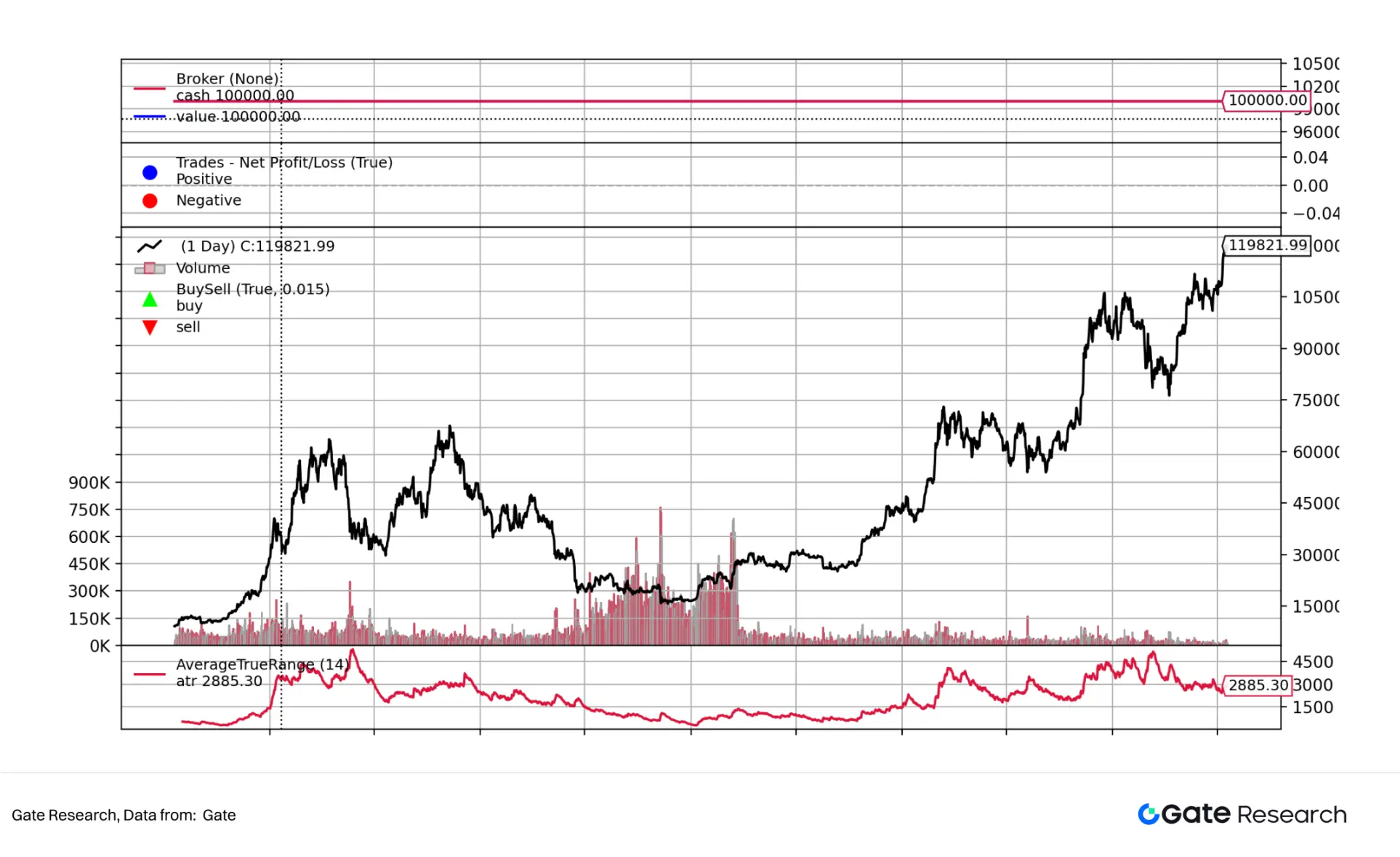
Stablecoins typically peg their value to fiat currencies, commodities, or other cryptocurrencies, or use algorithmic adjustment mechanisms to achieve value anchoring. They are widely used in the financial sector as a core medium for digital asset trading, DeFi applications, and cross-border payments.
Based on how they maintain their value, stablecoins can be classified into three types:
• Fiat-Collateralized Stablecoins
Fiat-collateralized stablecoins are the most common type, accounting for 92.4% of the market share. They achieve price stability by pegging tokens to fiat currencies like the U.S. dollar. Issuing institutions collateralize fiat or highly liquid assets (such as government bonds) in banks or custody accounts, then mint and issue tokens at a 1:1 ratio. Examples include USDT and USDC, with the following chart showing the USDT price curve.
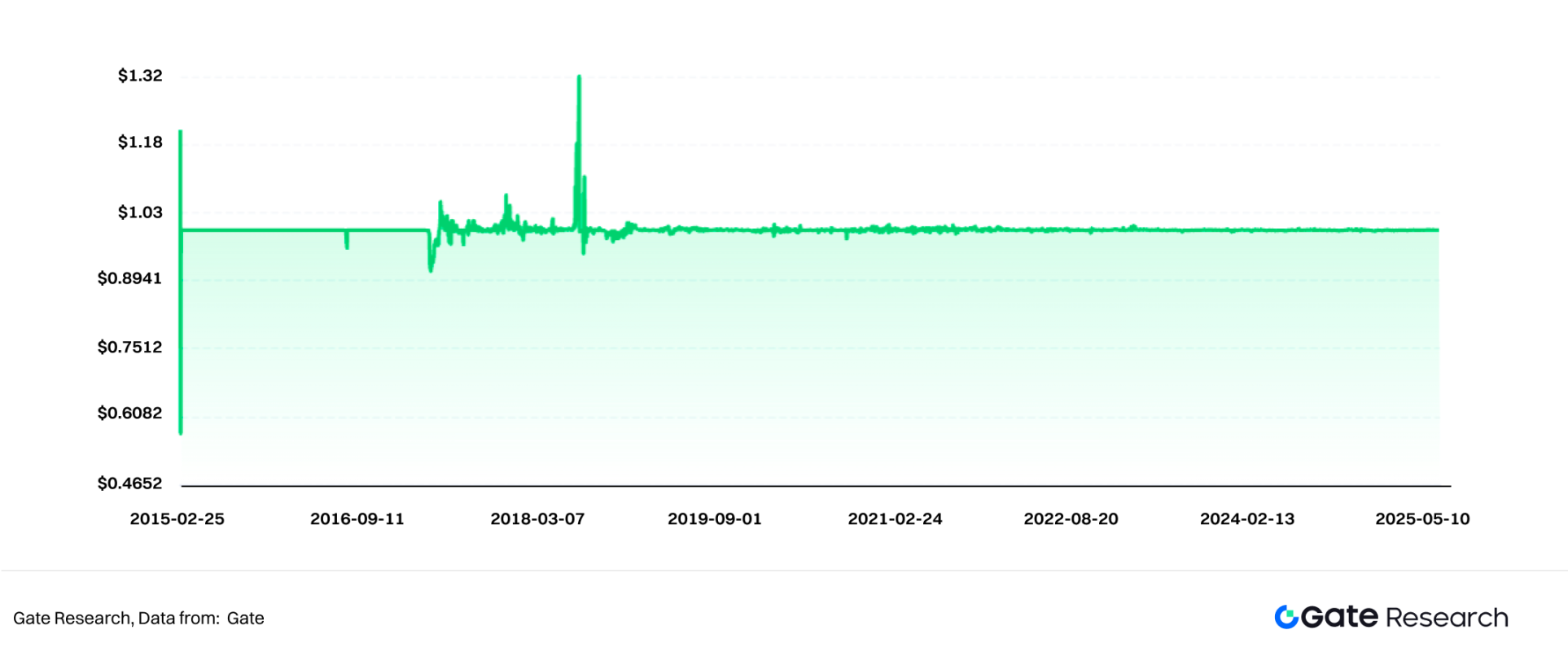
• Cryptocurrency-Collateralized Stablecoins
Unlike fiat-collateralized stablecoins, cryptocurrency-collateralized stablecoins use cryptocurrencies as collateral. Due to the high volatility of cryptocurrencies, they often employ over-collateralization (with collateral ratios typically around 150%) and introduce on-chain liquidation mechanisms to maintain the value of the stablecoin. For example, DAI issued by MakerDAO (Sky) allows users to mint DAI tokens by over-collateralizing ETH. The following chart shows the DAI price curve.
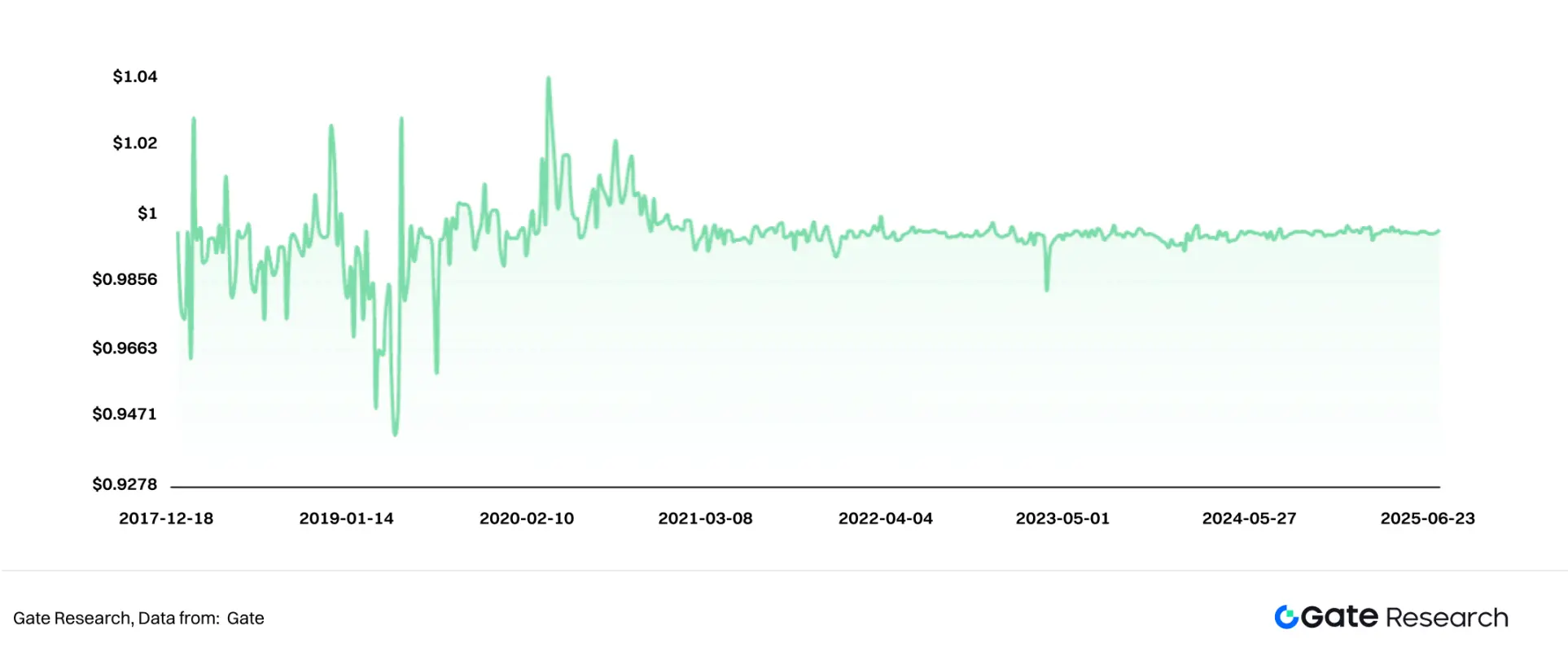
• Algorithmic Stablecoins
This type of stablecoin does not rely on physical asset backing but instead uses algorithms and market supply and demand to maintain token prices. When the token price exceeds $1, the system increases the token supply to lower the price; when the price falls below $1, the system buys back and destroys tokens to raise the price. For example, UST (which has collapsed) became an independent cryptocurrency, USTC, in 2025, no longer pegged to the U.S. dollar. The following chart shows the USTC price curve.
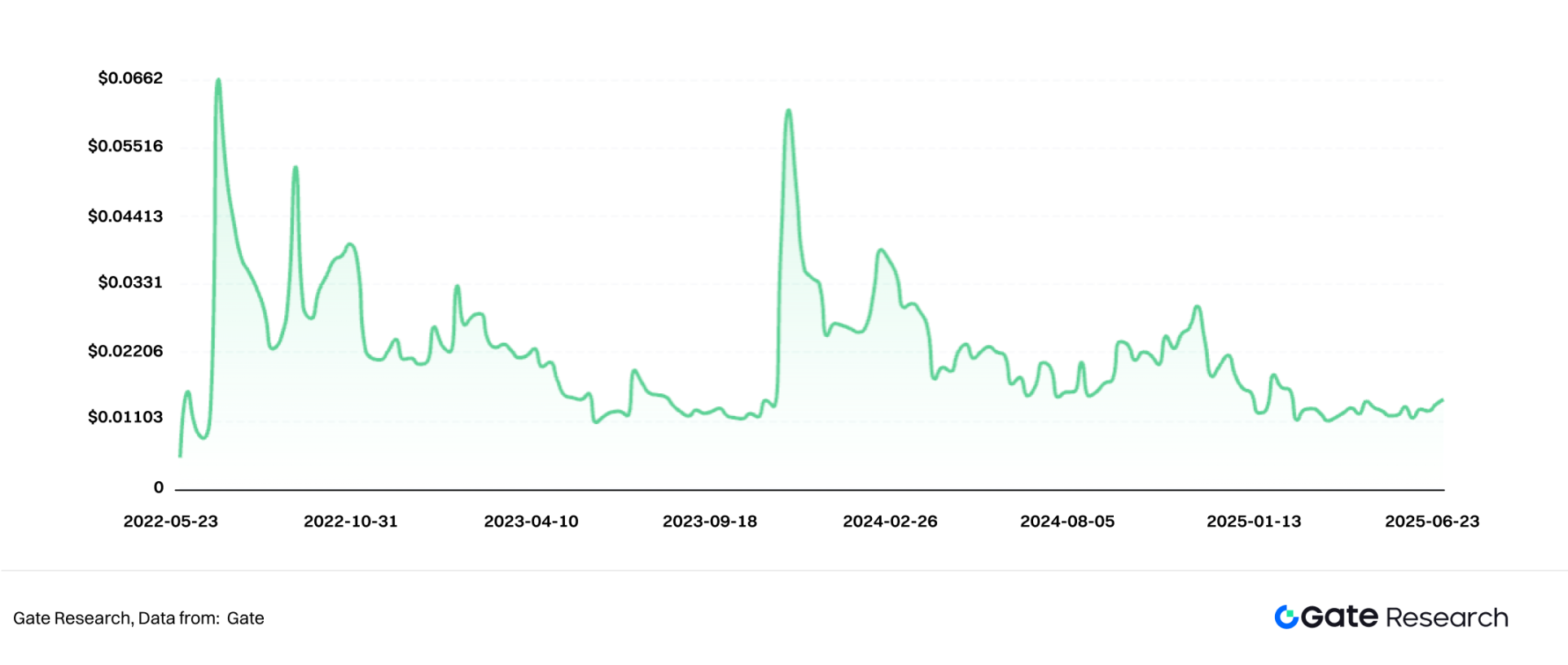
Comparison of the Three Types of Stablecoins

1.2 Characteristics of Stablecoins
The unique value anchoring mechanism of stablecoins distinguishes them from the extreme volatility of traditional cryptocurrencies, leading to their widespread perception as "digital cash" or "bridge assets" within the crypto asset ecosystem. They have the following main characteristics:
• Price Stability
By pegging to stable assets like the U.S. dollar or gold, or employing over-collateralization mechanisms and algorithmic adjustment mechanisms, stablecoins achieve lower price volatility, possessing stronger attributes as a store of value and medium of exchange.
• Bridging Traditional Finance and Decentralized Finance (DeFi)
Stablecoins are issued on the blockchain with traditional finance as the underlying asset, allowing interaction with on-chain protocols and tools, especially playing a crucial role in core applications such as DeFi lending, liquidity mining, and derivatives trading.
• Lower Payment Costs and Higher Efficiency
Leveraging blockchain technology, stablecoins can facilitate near-real-time cross-border transfers, with transaction fees significantly lower than traditional banking systems, and without geographical or time constraints, greatly enhancing the efficiency of capital circulation.
• Inflation Resistance and Capital Hedging
Most stablecoins are pegged to U.S. dollar assets, meaning they have the same inflation characteristics as the dollar. In countries with severe inflation or currency depreciation (such as Argentina and Turkey), stablecoins have become an important means for residents to hedge against risks and preserve assets due to their stability. In some regions of Africa and Latin America, stablecoins have become tools for daily payments.
1.3 Major Application Scenarios
Based on the characteristics of stablecoins mentioned above, they are currently applied in various scenarios including decentralized finance, cryptocurrency trading, cross-border trade, daily payments, and capital hedging. Among these, cross-border trade is a key area of focus in the recent legislation in the U.S. and Hong Kong. Using stablecoins for transactions not only effectively avoids the inflation issues of individual national currencies but also offers payment costs and efficiency far superior to the traditional SWIFT system.
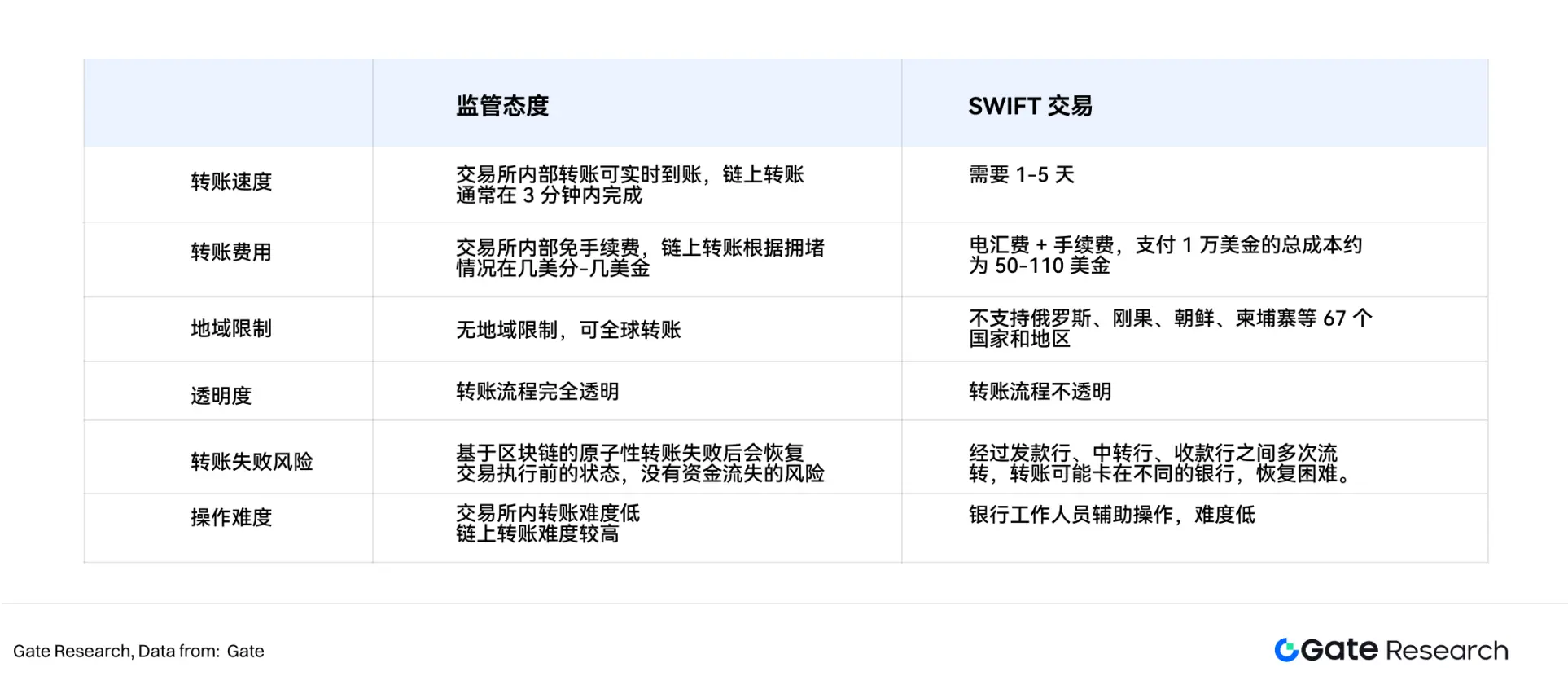
Legislative Background
2.1 The Rise of Stablecoins
Currently, the global market capitalization of stablecoins has reached $260.728 billion, surpassing the market capitalization of MasterCard, and accounting for approximately 1% of the nominal GDP of the United States in 2024. Stablecoins are an important component of the international financial system that cannot be ignored. The penetration rate of stablecoins continues to rise globally, with over 170 million stablecoin holders, representing about 2% of the global population, widely distributed across more than 80 countries and regions.
2.2 Motivations for Government Intervention in Regulation
Governments around the world are actively intervening in stablecoin regulation, motivated not only by the need to prevent financial risks but also by core interests related to monetary sovereignty, financial security, and cross-border capital control, as well as to mitigate the credit risks of fiat currencies.
• Preventing Systemic Financial Risks: Avoiding the loss of control over stablecoins that could lead to turmoil in payment systems and capital markets, and preventing the spillover of risks similar to the 2008 shadow banking crisis.
• Maintaining Monetary Sovereignty and Financial Order: Preventing private stablecoins from replacing fiat currencies in domestic circulation, thereby weakening central banks' control over monetary policy and payment systems.
• Combating Illegal Cross-Border Capital Flows: Stablecoins can bypass regulatory systems like SWIFT, and governments are concerned about their potential misuse in money laundering, tax evasion, and sanctions evasion.
• Hedging Against the Impact of "Dollar Stablecoin Hegemony": The U.S. promotes USDT/USDC as "on-chain dollars," while other countries explore legislation for local stablecoins (such as Hong Kong dollar, euro, and renminbi) as a countermeasure.
• Mitigating Fiat Currency Credit Risks and Supporting National Debt: By 2025, the market capitalization of dollar stablecoins exceeded $260 billion, with U.S. Treasury securities generally accounting for over 60%-80% of reserve assets. The demand for stablecoin reserves has become an important buyer of U.S. Treasury bonds, providing ongoing support for the credit of the dollar.
To strengthen the international status of their currencies, protect consumer asset security, seize discourse power in the digital asset field, and address the lack of regulation surrounding stablecoins, the U.S., Hong Kong, and Europe have successively introduced systematic regulatory frameworks, marking the formal entry of the stablecoin industry into a strong regulatory and compliance era.
Progress of Stablecoin Regulation in Major Global Economies
Since 2022, with the expansion of stablecoins in the global market, various countries have issued relevant regulations for oversight. The following chart shows the timeline of stablecoin regulatory progress in different countries:
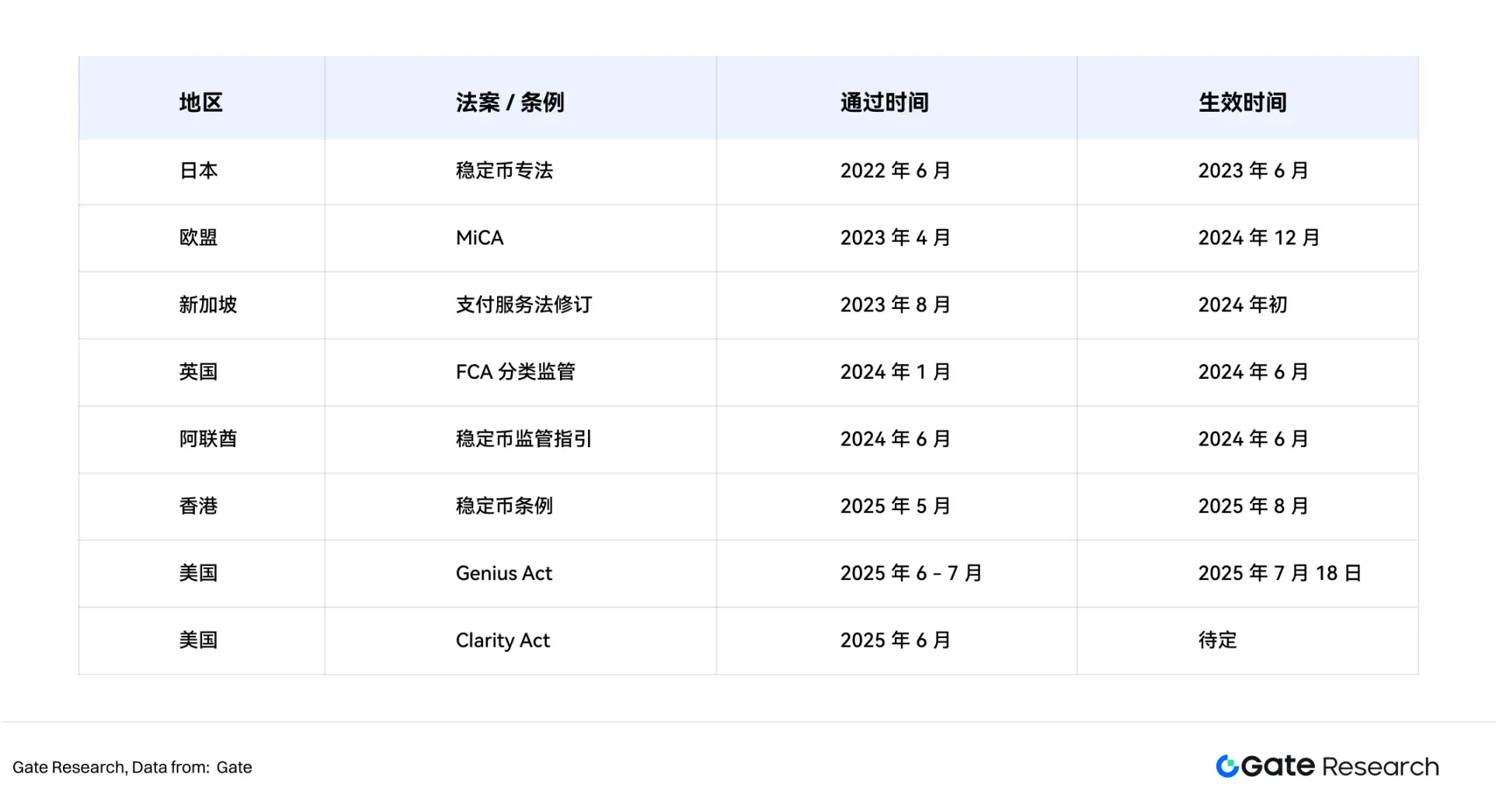
3.1 The U.S. Introduces the "Genius Act" and "Clarity Act"
The well-known Genius Act (Guiding and Establishing National Innovation for U.S. Stablecoins Act) was passed by the Senate on June 17, 2025, and by the House of Representatives on July 17, 2025, with a vote of 308–122. President Trump signed it into effect on July 18, 2025. This marks the first time the U.S. has established a unified regulatory framework for stablecoin issuance at the federal level. Its core contents include:
• Regulatory Model: A dual-track system of federal and state regulation, with the Office of the Comptroller of the Currency (OCC) providing unified authorization and licensing.
• Issuing Entities: Limited to banks, deposit institutions, and specific non-bank financial institutions approved.
• Reserve Requirements: A requirement for 1:1 fiat reserves, with reserve assets needing to be U.S. Treasury securities or cash to ensure the redeemability of stablecoins.
• Transparency Obligations: Issuers must undergo monthly audits, information disclosures, and anti-money laundering reviews.
• Business Restrictions: Prohibiting issuers from providing interest on stored value or engaging in leveraged, securitized, or other financial activities to curb the accumulation of systemic risks.
• Cross-Border Restrictions: Prohibiting unapproved foreign stablecoins from circulating in the U.S. market, reinforcing the firewall in capital markets.
On the same day, the Clarity Act (Digital Asset Market Clarity Act) was passed by the House of Representatives and sent to the Senate for review. The main purpose is to clarify the regulatory responsibilities of the SEC and CFTC in the digital asset market, covering trading platforms, crypto derivatives, DeFi, and more.
3.2 Hong Kong Introduces the "Stablecoin Regulation"
The Legislative Council of Hong Kong passed the "Stablecoin Regulation" on May 21, 2025, which will officially take effect on August 1, 2025. The main contents include:
• Licensing System: All activities related to the issuance, sale, and marketing of stablecoins must obtain permission from the Hong Kong Monetary Authority (HKMA).
• Scope of Application: Focuses on stablecoins pegged to fiat currencies, excluding purely crypto-asset pegged products.
• Capital Requirements: A minimum capital requirement of HKD 25 million, with effective risk management and internal control mechanisms.
• Reserve Requirements: 100% physical or equivalent liquid asset reserves, subject to regular audits and disclosures.
• Anti-Money Laundering and Consumer Protection: Strict compliance with AML/CFT regulations and investor suitability requirements.
• Liability for Violations: Conducting related business without permission will constitute criminal liability, with penalties including imprisonment and fines.
There are significant differences between the compliance requirements for stablecoins in Hong Kong and the United States:
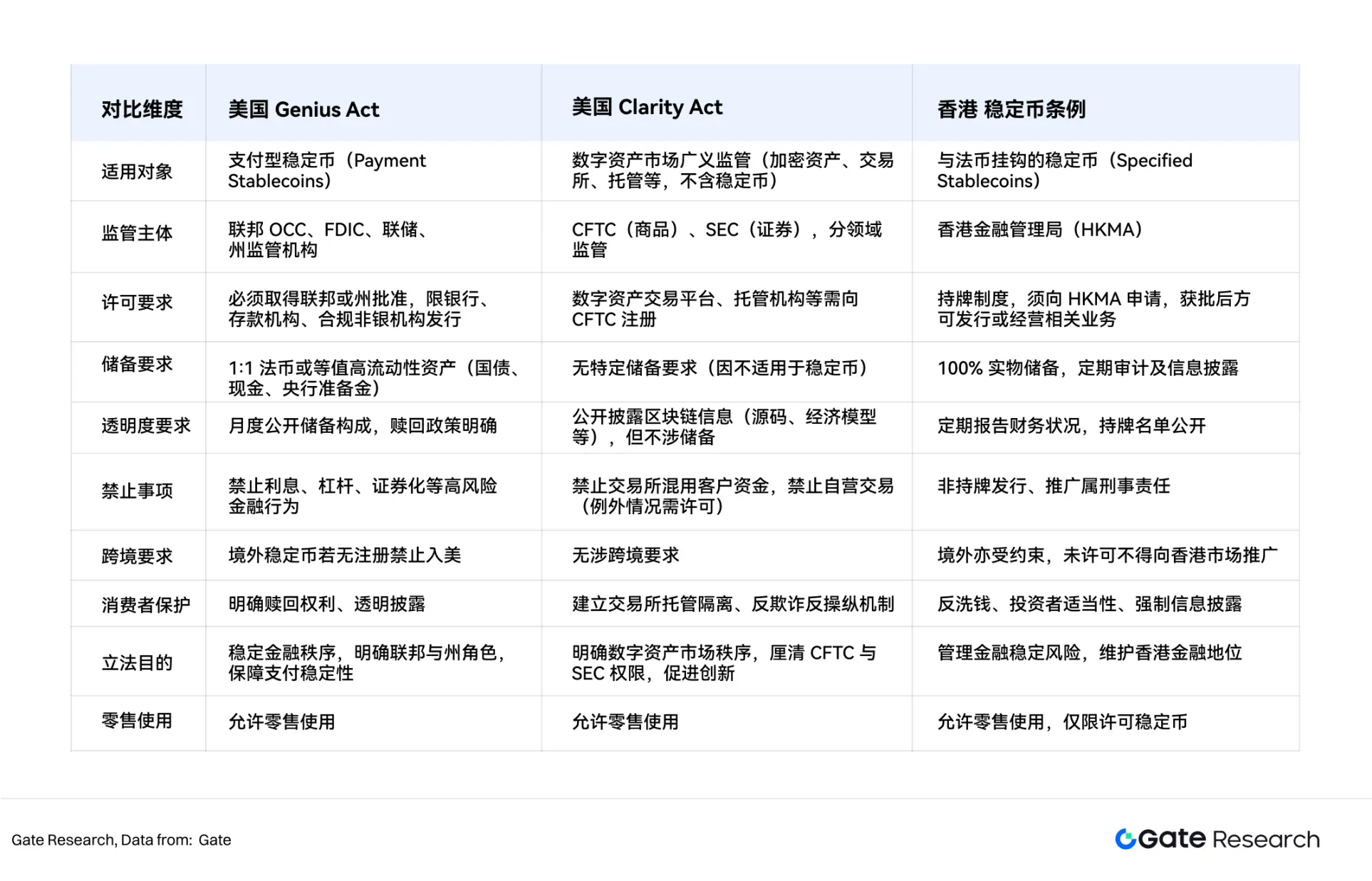
3.3 Developments in Other Economies
In addition to the United States and Hong Kong, other major economies are also actively advancing regulatory frameworks related to stablecoins, showing a trend of cautious tightening and gradual formation.
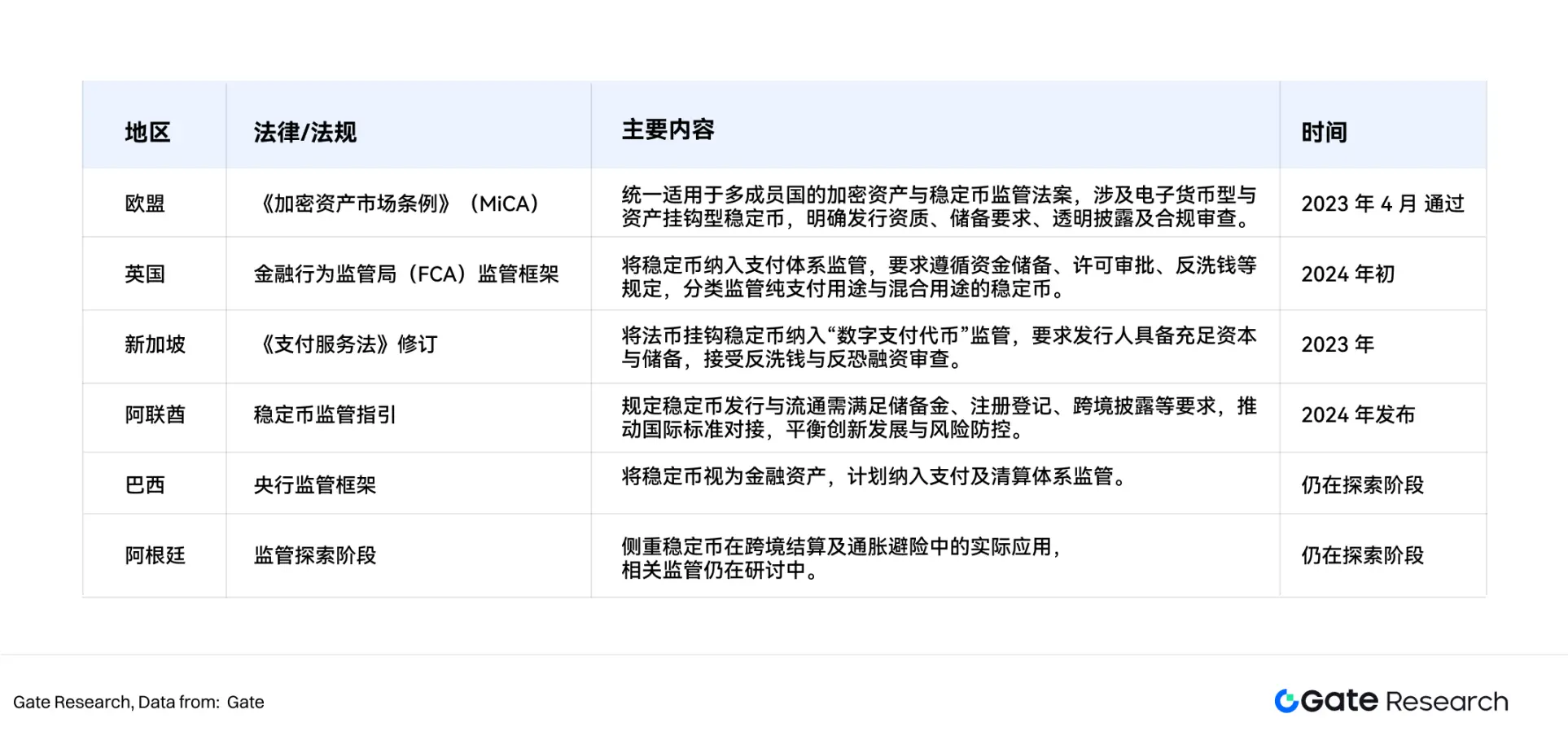
Overall, the regulatory scope in various countries primarily focuses on collateralized stablecoins, excluding high-risk algorithmic stablecoins, which will further restrict the development of algorithmic stablecoins. Additionally, Hong Kong only recognizes fiat-collateralized stablecoins and does not acknowledge the issuance and circulation of cryptocurrency-collateralized stablecoins, further consolidating the dominance of fiat-collateralized stablecoins.
Although the regulatory attitudes and progress regarding stablecoins vary among countries, they generally build frameworks around core principles such as "reserve transparency, anti-money laundering review, consumer protection, and financial stability," gradually aligning with their national digital asset or financial system regulations.
Reshaping Financial Order Under Stablecoin Dominance
4.1 The Competition for Financial Sovereignty Behind Stablecoins
Currently, stablecoins pegged to the U.S. dollar account for over 90% of the market capitalization in the stablecoin market, with products like USDT and USDC forming a de facto standard in global exchanges, DeFi, and cross-border payments. This situation not only continues the dollar's position in traditional finance but also completes the deep penetration of the dollar's influence into the new digital financial ecosystem through stablecoins.
Legislation such as the U.S. "Genius Act" explicitly states that U.S. dollar stablecoins must be backed by high-quality assets such as U.S. Treasury securities and short-term notes, reinforcing the binding relationship between stablecoins and core dollar assets (Treasuries). This mechanism creates a "stablecoin - U.S. Treasury" dual anchoring structure, where stablecoin issuers hold large amounts of U.S. Treasuries, indirectly providing continuous buying support for the U.S. Treasury, further solidifying the dollar's dominant position in the global financial system. This mechanism forms a "latent buying relationship" between stablecoins and dollar assets, reinforcing the foundation of U.S. financial hegemony globally.
The widespread circulation of dollar stablecoins around the world has created a trend of "on-chain dollarization" in many emerging markets and high-inflation countries, eroding the use cases of local currencies and financial sovereignty. For example, in Argentina, Turkey, and Russia, USDT has become the default tool for residents to preserve assets and conduct cross-border payments. This phenomenon is viewed in literature as the dollar's digital penetration into financially vulnerable countries, undermining the monetary policy independence of these nations.
At the same time, the compliance progress of fiat stablecoins such as the euro and Hong Kong dollar reflects countries' attempts to hedge against the spillover effects of dollar stablecoins through local currency digitization and stablecoin legislation. A new round of currency competition in the digital age has begun, shifting the struggle for financial hegemony from traditional systems to on-chain ecosystems.
4.2 Competition for Next-Generation Financial Infrastructure
Stablecoins carry not only payment and transaction functions but are also gradually becoming core components of the new generation of cross-border payment and clearing infrastructure. Compared to the traditional SWIFT system, stablecoins offer advantages such as real-time settlement, low costs, and decentralization. The U.S. hopes to replicate the infrastructure hegemony of SWIFT in the on-chain financial world through dollar stablecoins, incorporating global payment, settlement, and custody services into its regulatory framework. Meanwhile, international financial centers like Hong Kong and Singapore are promoting the deep integration of local financial infrastructure with fiat stablecoins through policy guidance, aiming to seize positions as cross-border digital financial hubs and nodes.
4.3 Competition for Digital Asset Pricing Power
In the current digital asset market, stablecoins are not only mediums of exchange but also deeply involved in the reshaping of digital asset market pricing power. USDT and USDC almost monopolize the main trading pairs in the crypto market, becoming the de facto standard for liquidity anchoring and pricing of on-chain assets. Changes in their supply directly affect the overall market risk appetite and volatility levels.
The U.S. has strengthened its control over pricing power and liquidity dominance in the digital asset market through stablecoin legislation and regulation, indirectly solidifying the dollar's core position in global capital markets. Meanwhile, regions like Hong Kong and the European Union are promoting local currency stablecoins to seek more regional pricing power and influence in future digital financial competition.
Risks and Challenges
The risks associated with stablecoins stem from both the systemic risks posed by their price anchoring mechanisms and the compliance risks arising from external regulations.
5.1 Preventing Systemic Risks
The core of stablecoins' price stability lies in the value stability of their underlying assets. Therefore, the greatest systemic risk for stablecoins comes from the price volatility of their corresponding collateral leading to a decoupling of the stablecoin's price.
Looking back at the first stablecoin, BitUSD, which was released in 2014 and decoupled from its 1:1 peg to the dollar in 2018, this was due to its collateral being an obscure, highly volatile asset with no guarantees—BitShares.
In the same year, MakerDAO issued DAI, which employed an over-collateralization mechanism and liquidation mechanism to combat the risks posed by the high volatility of crypto assets. However, it fundamentally could not enhance capital efficiency and exposed the stablecoin to the price volatility risks of the collateral assets. Similarly, stablecoins backed by fiat assets do not guarantee absolute safety.
In March 2023, due to the collapse of three U.S. banks (Silicon Valley Bank (SVB), Signature Bank, and Silvergate Bank), both USDC and DAI experienced decoupling. According to Circle, the issuer of USDC, $3.3 billion of cash reserves backing the stablecoin were held at SVB, leading to a single-day drop of over 12% for USDC.
DAI's value also experienced fluctuations, primarily because more than half of its collateral reserves were linked to USDC and related instruments. The situation stabilized only after the Federal Reserve announced support for bank creditors, allowing USDC and DAI to return to their respective pegged levels. Subsequently, both stablecoins adjusted their reserve structures, with USDC primarily holding its cash reserves at Bank of New York Mellon, while DAI diversified its reserves into various stablecoins and increased its holdings in real-world assets (RWA).
This chain reaction of decoupling events serves as a reminder for stablecoin issuers to diversify their asset allocations to combat systemic risks.
5.2 Contradiction to Decentralization Principles
Although stablecoins have once promoted the widespread use and compliant access of cryptocurrencies, their mainstream models (such as USDT and USDC) rely on centralized entities for operation and fiat asset backing, which contradicts the core principles of decentralization and censorship resistance inherent in blockchain technology.
Some scholars argue that fiat-collateralized stablecoins are essentially on-chain mirrors of fiat currencies like the U.S. dollar, fundamentally reinforcing dependence on the traditional financial system (dollar, banking system) and creating a "centralized core beneath a decentralized facade," undermining the original ideals of cryptocurrency decentralization.
This centralized dependence not only subjects stablecoins to the credit risks of issuers and custodians but may also lead to freezing or tampering under extreme circumstances (compliance policies, censorship pressures), violating the essential purpose of blockchain as "permissionless and immutable."
5.3 Difficulties in Cross-Border Regulatory Coordination
Globally, stablecoins involve multiple jurisdictions, cross-border finance, and data flows, but there are significant differences in countries' regulatory stances, definitions, and compliance requirements regarding stablecoins:

Due to the substantial differences in regulatory frameworks among countries, there is considerable uncertainty and legal risk in the cross-border use, clearing, and compliance processes of stablecoins, which can easily lead to "regulatory arbitrage" and compliance gaps, hindering their global development.
5.4 Potential Financial Sanction Risks
With the international situation becoming increasingly volatile, stablecoins also face the risk of being incorporated into financial sanction toolchains. The U.S. may leverage its regulatory dominance over dollar stablecoins to enhance scrutiny over capital flows and fund usage, potentially implementing freezing or blocking sanctions against specific entities or countries.
Alexander Baker points out that stablecoins have, to some extent, become an extension of on-chain dollars, and may in the future become part of the U.S. financial weaponization toolkit, similar to traditional systems like SWIFT. For some emerging markets, cross-border transactions, and on-chain financial projects, this undoubtedly increases political and compliance risk exposure, driving further exploration of de-dollarization and regional fiat stablecoins globally.
Conclusion
The rise of stablecoins is a microcosm of the reshaping of monetary order in the digital financial era. Since their inception, stablecoins have continuously penetrated various fields such as payments, transactions, and asset reserves, and with their efficiency, low cost, and programmability, they are gradually becoming an important bridge linking traditional finance and the digital economy. Today, stablecoins are not only core infrastructure in the crypto market but also profoundly influence the evolution of the global financial landscape, increasingly being incorporated into the financial regulatory and monetary strategy frameworks of many countries.
Behind the rise of stablecoins is a covert competition between monetary sovereignty and financial hegemony. The dominant position of dollar stablecoins in the global market further consolidates the dollar's supremacy in the on-chain world, and the deep binding of their reserve structures with U.S. Treasuries makes stablecoins an important extension tool of U.S. financial strategy. Meanwhile, emerging markets and other major economies are attempting to gradually weaken the penetration effects of dollar stablecoins through local currency stablecoins, digital currency regulation, and the construction of cross-border payment systems, promoting global currency diversification and local currency digitization. Stablecoin legislation has become a key variable in the future reshaping of the international financial order, reflecting deeper layers of national interests and the redistribution of financial power.
However, the future development of stablecoins still faces many uncertainties. Firstly, the systemic risks inherent in the anchoring mechanism and reserve structure are difficult to eliminate completely in the short term, leaving potential trust crises and market volatility risks. Secondly, a unified global regulatory framework has yet to be established, and there are many obstacles to cross-border regulatory coordination and legal applicability, causing stablecoins to remain in a gray area and face ongoing compliance and policy risks. Thirdly, issues such as centralized issuance and financial weaponization create inherent tensions with the original ideals of decentralization and censorship resistance in blockchain. How to balance regulatory compliance with technological autonomy remains a core issue that the industry must confront.
In the future, stablecoins will play an increasingly important role in financial infrastructure, currency competition, and the international settlement system. Their development path is not only related to the deep integration of decentralized finance and real-world assets but also to the construction of a new global financial order and the redistribution of discourse power.
References
• Gate, https://www.gate.com/zh/price
• Sky, https://sky.money/
• Deltec, https://www.deltecbank.com/news-and-insights/the-history-of-stablecoins/
• Tether, https://tether.to/en/
• DeFiLlama, https://defillama.com/stablecoin/dai
• CSPengyuan, https://www.cspengyuan.com/pengyuancmscn/credit-research/macro-research
• rwa.xyz, https://app.rwa.xyz/stablecoins?utm_source=substack&utm_medium=email
• Swift, https://www.swift.com/about-us/legal/document-centre
• Congress, https://www.congress.gov/bill/119th-congress/senate-bill/394/text
• Whitehouse, https://www.whitehouse.gov/fact-sheets/2025/07/fact-sheet-president-donald-j-trump-signs-genius-act-into-law/
免责声明:本文章仅代表作者个人观点,不代表本平台的立场和观点。本文章仅供信息分享,不构成对任何人的任何投资建议。用户与作者之间的任何争议,与本平台无关。如网页中刊载的文章或图片涉及侵权,请提供相关的权利证明和身份证明发送邮件到support@aicoin.com,本平台相关工作人员将会进行核查。




